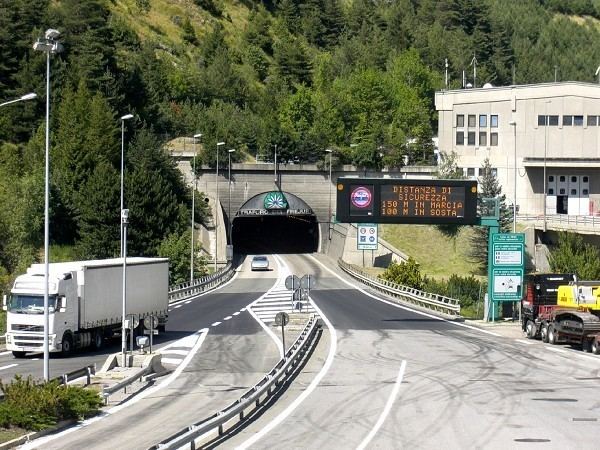Opened 1980 | Length 12.87 km (8.00 mi) Start Bardonecchia | |
 | ||
Similar Mont Blanc Tunnel, Alps, Mont Cenis, Col de Montgenèvre, Maurienne | ||
Fr jus road tunnel
The Fréjus Road Tunnel is a tunnel that connects France and Italy. It runs under Col du Fréjus in the Cottian Alps between Modane in France and Bardonecchia in Italy. It is one of the major trans-Alpine transport routes between France and Italy being used for 80% of the commercial road traffic.
Contents
- Fr jus road tunnel
- Map of Traforo Stradale del Frejus 73500 Modane France
- Easy job frejus tunnel
- Safety
- Frjus Underground Laboratory
- References
Map of Traforo Stradale del Frejus, 73500 Modane, France
Construction of the 13 km (8.1 mi) long tunnel started in 1974, and it came into service on 12 July 1980, leading to the closure of the motorail shuttle service in the Fréjus rail tunnel. It cost 2 billion francs (equivalent to €700 million at 2005 prices). It is the ninth longest road tunnel in the world (as of 2014).
The French section is managed by the French company SFTRF, and the Italian section by the Italian firm SITAF. (The French politician Pierre Dumas was chairman of SFTRF from 1962 to 1989). The tunnel can be reached from the Italian side by the A32 Torino-Bardonecchia motorway, or by SS335 from Oulx, which joins SS24 (“del Monginevro”), and reaches Bardonecchia after 20 km. From the French side, it can be reached by the A43 (‘’l’Autoroute de la Maurienne’’) from Lyon and Chambéry. A toll is charged to all traffic. Over 20 million vehicles passed through the tunnel during the first 20 years.
Easy job frejus tunnel
Safety
Following a 1999 accident in the Mont Blanc tunnel, measures were taken at the start of 2000 to improve safety in the tunnel. A strict 70 km/h speed limit, and a safe distance of 150 m between vehicles was imposed. The tunnel was equipped with the latest smoke and flame detectors, and a system of videocameras in the tunnel to detect the speed of traffic, as well as fire and smoke. Temperature sensors were installed at short distances throughout the tunnel, monitored from a central control post. Fire hydrants were installed every 130 m, fed from large water tanks. There are 11 safety points along the tunnel, equipped with telephones and loud speakers connected to the control room, with a separate ventilation duct to supply fresh air. These are separated from the main tunnel by two fire doors; the outer door closes automatically when the temperature in the tunnel reaches a certain level. Finally there is a ‘thermal gate’ system at each entrance to identify any overheating vehicles.
Despite these measures, on 4 June 2005, a fire caused the death of two Slovak lorry drivers, and the closure of the tunnel to traffic for several weeks. It reopened to cars on 4 August 2005, and later to commercial vehicles. The tunnel was also briefly closed due to non-fatal fires on 9 January 2007, 29 November 2010, and 10 April 2014.
In 2007, an 8-meter-wide rescue tunnel parallel to the main highway was constructed.
The firefighting team consists of four intervention teams: positioned on the Italian and French sides, and two inside the tunnel, about 4 km from each end.
Fréjus Underground Laboratory
Near the midpoint is the Laboratoire Souterrain de Modane (also referred to as the Fréjus Underground Laboratory). This site houses the Neutrino Ettore Majorana Observatory (NEMO experiment), an international collaboration of scientists searching for neutrinoless double beta decay. An observation of neutrinoless double beta decay would be evidence that neutrinos are Majorana particles and could be used to measure the neutrino mass. Attempts are underway to build a larger laboratory, either in the same tunnel or in the even deeper Lyon Turin Ferroviaire 15 km to the east.
